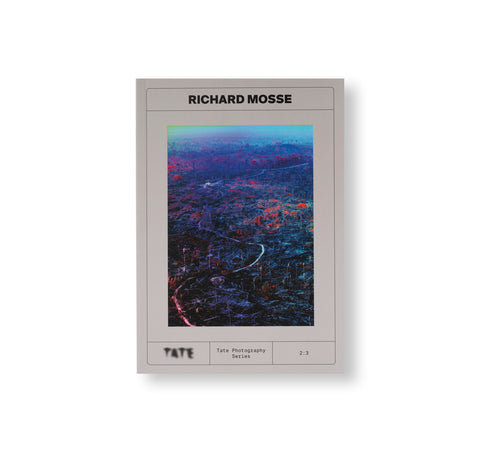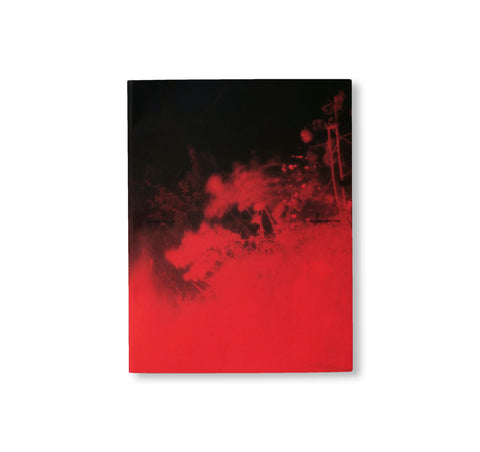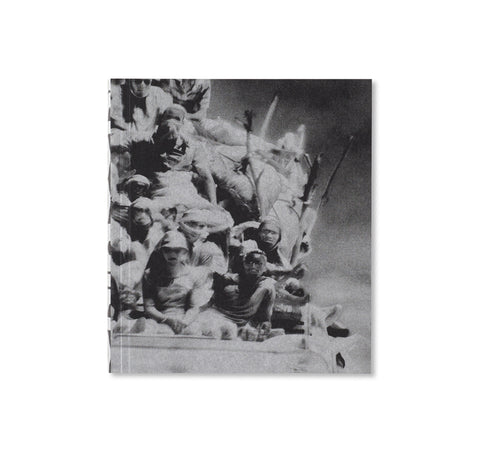THE CASTLE by Richard Mosse [FIRST EDITION, SECOND PRINTING]
Deutsche Börse Photography Prize 受賞のアイルランド人フォトグラファー、リチャード・モス(Richard Mosse)の作品集。ここ数年作者は難民・移民危機という継続的な問題を追いかけ、軍事規格のカメラ技術を駆使した写真を通じ、難民に対する政府や社会の見方に対し挑んできた。本作は、中東や中央アジアからトルコを抜けて欧州に入る大規模な難民・移民流入ルートに沿ってできたいくつもの難民キャンプや周辺地域の詳細な記録である。モーションコントロール技術を用いたロボットアームに、長距離国境警備や武装勢力の検知に使用される赤外線サーマルビデオカメラを取り付け高いところから撮影を敢行、様々な難民キャンプの全景を俯瞰的なイメージに収めた。こうすることで、それぞれのキャンプが周囲の市民のインフラとどのように関わっているのか、あるいは切り離されているのかを浮かび上がらせる。素材となる映像を何百ものフレームに分解し、コンピューター上でグリッドの構成に重ね合わせていくことによって合成の「ヒートマップ」を作りだした。時間と空間を切り取って作られたイメージは、人生が一旦停止したような、いつ終わるとも知れない宙ぶらりの日々の中で亡命が認められることを待ち続けるという難民たちの実体験に言及している。本書に収められた28の難民キャンプはそれぞれに注釈がつき、クロースアップされたシークエンスとしてそれぞれのページに表現され、開くと1枚のパノラマヒートマップとなる。このフォーマットの中で作者は、難民キャンプに見られる間にあわせの設備と共に国家やコミュニティがキャンプを社会の隅に追いやり、隠させ、厳しく管理し、軍隊を配置し、同化し、分散する多様なやり方を強調する。作者の作品は、グローバル化した資本主義の活発な自由貿易とEU諸国における国際難民法の非人間的な崩壊の間の誰の目にも明らかな断絶を指し示している。1926年に刊行されたカフカの未完小説『城』から名付けられた本書は、我々に難民の「可視性」と人権の侵害について問うことを求める。イラン人難民として現在オーストラリア政府によりパプアニューギニアのマヌス島に拘禁されている、ジャーナリストで作家のベルーズ・ブーチャニ(Behrouz Boochani)の詩、ペンシルベニア大学の英文学助教授ポール・K・サンタムール(Paul K. Saint-Amour)のエッセイ、哲学者ジュディス・バトラー(Judith Butler)のエッセイ、リチャード・モス本人の文章を収録。
記事:熱感知カメラが捉えた難民と苦境(Newsweek Japan)
Richard Mosse has spent the past few years documenting the ongoing refugee and migration crisis, repurposing military-grade camera technology to confront how governments and societies perceive refugees. His latest book The Castle is a meticulous record of refugee camps located across mass migration routes from the Middle East and Central Asia into the European Union via Turkey. Using a thermal video camera intended for long-range border enforcement, Mosse films the camps from high elevations to draw attention to the ways in which each interrelates with, or is divorced from, adjacent citizen infrastructure. His source footage is then broken down into hundreds of individual frames, which are digitally overlapped in a grid formation to create composite heat maps. Truncating time and space, Mosse’s images speak to the lived experience of refugees indefinitely awaiting asylum and trapped in a Byzantine state of limbo. The book is divided into 28 sites, each presenting an annotated sequence of close-up images that fold out into a panoramic heat map. Within this format, Mosse underscores the provisional architecture of the camps and the ways in which each camp is variously marginalised, concealed, regulated, militarized, integrated, and/or dispersed. His images point to the glaring disconnect between the brisk free trade of globalized capitalism and the dehumanizing erosion of international refugee law in European nation states. Named after Kafka’s 1926 novel, The Castle prompts questions about the ‘visibility’ of refugees and the erosion of their human rights. The book comes with a separate book of texts, including a poem by Behrouz Boochani, the journalist, novelist and Iranian refugee currently held by the Australian government in confinement on Manus island, an essay by Paul K. Saint-Amour, associate Professor of English at the University of Pennsylvania, an essay by philosopher Judith Butler, and a text by Richard Mosse.
![THE CASTLE by Richard Mosse [FIRST EDITION, SECOND PRINTING]](http://twelve-books.com/cdn/shop/products/181114_11408.jpg?v=1571703976)
![THE CASTLE by Richard Mosse [FIRST EDITION, SECOND PRINTING]](http://twelve-books.com/cdn/shop/products/181114_11412.jpg?v=1571703976)
![THE CASTLE by Richard Mosse [FIRST EDITION, SECOND PRINTING]](http://twelve-books.com/cdn/shop/products/181114_11414.jpg?v=1571703976)
![THE CASTLE by Richard Mosse [FIRST EDITION, SECOND PRINTING]](http://twelve-books.com/cdn/shop/products/181114_11415.jpg?v=1571703976)
![THE CASTLE by Richard Mosse [FIRST EDITION, SECOND PRINTING]](http://twelve-books.com/cdn/shop/products/181114_11416.jpg?v=1571703976)
![THE CASTLE by Richard Mosse [FIRST EDITION, SECOND PRINTING]](http://twelve-books.com/cdn/shop/products/181114_11422.jpg?v=1571703976)
![THE CASTLE by Richard Mosse [FIRST EDITION, SECOND PRINTING]](http://twelve-books.com/cdn/shop/products/181114_11429.jpg?v=1571703976)
![THE CASTLE by Richard Mosse [FIRST EDITION, SECOND PRINTING]](http://twelve-books.com/cdn/shop/products/181114_11430.jpg?v=1571703976)
![THE CASTLE by Richard Mosse [FIRST EDITION, SECOND PRINTING]](http://twelve-books.com/cdn/shop/products/181114_11431.jpg?v=1571703976)
![THE CASTLE by Richard Mosse [FIRST EDITION, SECOND PRINTING]](http://twelve-books.com/cdn/shop/products/181114_11434.jpg?v=1571703976)
![THE CASTLE by Richard Mosse [FIRST EDITION, SECOND PRINTING]](http://twelve-books.com/cdn/shop/products/181114_11438.jpg?v=1571703976)
![THE CASTLE by Richard Mosse [FIRST EDITION, SECOND PRINTING]](http://twelve-books.com/cdn/shop/products/181114_11443.jpg?v=1571703976)
![THE CASTLE by Richard Mosse [FIRST EDITION, SECOND PRINTING]](http://twelve-books.com/cdn/shop/products/181114_11444.jpg?v=1571703976)
![THE CASTLE by Richard Mosse [FIRST EDITION, SECOND PRINTING]](http://twelve-books.com/cdn/shop/products/181114_11447.jpg?v=1571703976)
![THE CASTLE by Richard Mosse [FIRST EDITION, SECOND PRINTING]](http://twelve-books.com/cdn/shop/products/181114_11451.jpg?v=1571703976)
![THE CASTLE by Richard Mosse [FIRST EDITION, SECOND PRINTING]](http://twelve-books.com/cdn/shop/products/181114_11452.jpg?v=1571703976)
![THE CASTLE by Richard Mosse [FIRST EDITION, SECOND PRINTING]](http://twelve-books.com/cdn/shop/products/181114_11454.jpg?v=1571703976)
![THE CASTLE by Richard Mosse [FIRST EDITION, SECOND PRINTING]](http://twelve-books.com/cdn/shop/products/181114_11461.jpg?v=1571703976)
![THE CASTLE by Richard Mosse [FIRST EDITION, SECOND PRINTING]](http://twelve-books.com/cdn/shop/products/181114_11465.jpg?v=1571703976)
![THE CASTLE by Richard Mosse [FIRST EDITION, SECOND PRINTING]](http://twelve-books.com/cdn/shop/products/181114_11467.jpg?v=1571703976)
![THE CASTLE by Richard Mosse [FIRST EDITION, SECOND PRINTING]](http://twelve-books.com/cdn/shop/products/181114_11470.jpg?v=1571703976)
![THE CASTLE by Richard Mosse [FIRST EDITION, SECOND PRINTING]](http://twelve-books.com/cdn/shop/products/181114_11473.jpg?v=1571703976)
![THE CASTLE by Richard Mosse [FIRST EDITION, SECOND PRINTING]](http://twelve-books.com/cdn/shop/products/181114_11474.jpg?v=1571703976)
![THE CASTLE by Richard Mosse [FIRST EDITION, SECOND PRINTING]](http://twelve-books.com/cdn/shop/products/181114_11477.jpg?v=1571703976)
![THE CASTLE by Richard Mosse [FIRST EDITION, SECOND PRINTING]](http://twelve-books.com/cdn/shop/products/181114_11488.jpg?v=1571703976)
![THE CASTLE by Richard Mosse [FIRST EDITION, SECOND PRINTING]](http://twelve-books.com/cdn/shop/products/181114_11489.jpg?v=1571703976)
![THE CASTLE by Richard Mosse [FIRST EDITION, SECOND PRINTING]](http://twelve-books.com/cdn/shop/products/181114_11490.jpg?v=1571703976)
![THE CASTLE by Richard Mosse [FIRST EDITION, SECOND PRINTING]](http://twelve-books.com/cdn/shop/products/181114_11492.jpg?v=1571703976)
![THE CASTLE by Richard Mosse [FIRST EDITION, SECOND PRINTING]](http://twelve-books.com/cdn/shop/products/181114_11496.jpg?v=1571703976)
![THE CASTLE by Richard Mosse [FIRST EDITION, SECOND PRINTING]](http://twelve-books.com/cdn/shop/products/181114_11497.jpg?v=1571703976)
![THE CASTLE by Richard Mosse [FIRST EDITION, SECOND PRINTING]](http://twelve-books.com/cdn/shop/products/181114_11499.jpg?v=1571703976)
![THE CASTLE by Richard Mosse [FIRST EDITION, SECOND PRINTING]](http://twelve-books.com/cdn/shop/products/181114_11501.jpg?v=1571703976)
![THE CASTLE by Richard Mosse [FIRST EDITION, SECOND PRINTING]](http://twelve-books.com/cdn/shop/products/181114_11502.jpg?v=1571703976)
![THE CASTLE by Richard Mosse [FIRST EDITION, SECOND PRINTING]](http://twelve-books.com/cdn/shop/products/181114_11504.jpg?v=1571703976)
![THE CASTLE by Richard Mosse [FIRST EDITION, SECOND PRINTING]](http://twelve-books.com/cdn/shop/products/181114_11509.jpg?v=1571703976)
![THE CASTLE by Richard Mosse [FIRST EDITION, SECOND PRINTING]](http://twelve-books.com/cdn/shop/products/181114_11512.jpg?v=1571703976)
![THE CASTLE by Richard Mosse [FIRST EDITION, SECOND PRINTING]](http://twelve-books.com/cdn/shop/products/181114_11513.jpg?v=1571703976)
![THE CASTLE by Richard Mosse [FIRST EDITION, SECOND PRINTING]](http://twelve-books.com/cdn/shop/products/181114_11515.jpg?v=1571703976)
![THE CASTLE by Richard Mosse [FIRST EDITION, SECOND PRINTING]](http://twelve-books.com/cdn/shop/products/181114_11516.jpg?v=1571703976)
![THE CASTLE by Richard Mosse [FIRST EDITION, SECOND PRINTING]](http://twelve-books.com/cdn/shop/products/181114_11521.jpg?v=1571703976)
![THE CASTLE by Richard Mosse [FIRST EDITION, SECOND PRINTING]](http://twelve-books.com/cdn/shop/products/181114_11530.jpg?v=1571703976)
![THE CASTLE by Richard Mosse [FIRST EDITION, SECOND PRINTING]](http://twelve-books.com/cdn/shop/products/181114_11533.jpg?v=1571703976)



![INCOMING by Richard Mosse [SIGNED]](http://twelve-books.com/cdn/shop/products/170308_03428_d8802de2-db9e-4dea-8ac0-b583f4ceb138_large.jpg?v=1571703941)